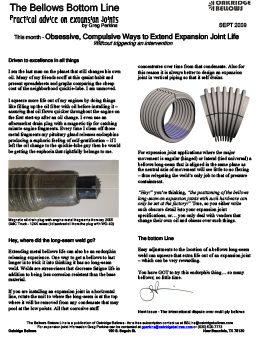Obsessive, Compulsive Ways to Extend Expansion Joint Life

Driven to excellence in all things.
I am the last man on the planet that still changes his own oil. Many of my friends scoff at this quaint habit and present spreadsheets and graphs comparing the cheap cost of the neighborhood quickie-lube. I am unmoved.
I squeeze more life out of my engines by doing things like filling up the oil filter with oil before installing it – ensuring that oil flows quicker throughout the engine on the first start-up after an oil change. I even use an aftermarket drain plug with a magnetic tip for catching minute engine fragments. Every time I clean off those metal fragments my pituitary gland releases endorphins producing a euphoric feeling of self-gratification – if I left the oil change to the quickie-lube guy then he would be getting the euphoria that rightfully belongs to me. Magnetic oil drain plug with engine metal fragments from my 2005 GMC Truck – 124K miles (I dissolved oil from the plug with WD-40)
Hey, where did the long-seam weld go?
Extending metal bellows life can also be an endorphin releasing experience. One way to get a bellows to last longer is to trick it into thinking it has no long-seam weld. Welds are stress-risers that decrease fatigue life in addition to being less corrosion resistant than the base material. If you are installing an expansion joint in a horizontal line, rotate the unit to where the long-seam is at the top where it will be removed from any condensate that may pool at the low points. All that corrosive stuff concentrates over time from that condensate. Also for this reason it is always better to design an expansion joint in vertical piping so that it self drains. For expansion joint applications where the major movement is angular (hinged) or lateral (tied universal) a bellows long-seam that is aligned in the same plane as the neutral axis of movement will see little to no flexing – thus relegating the weld’s only job to that of pressure containment.
“Hey!” you’re thinking,
“the positioning of the bellows long-seam on expansion joints with such hardware can only be set at the factory!” True, so you either write such obscure detail into your expansion joint specifications, or… you only deal with vendors that change their own oil and obsess over such things.
The bottom Line
Easy adjustments to the location of a bellows long-seam weld can squeeze that extra life out of an expansion joint – which can be very rewarding.
You have GOT to try this endorphin thing… so many bellows; so little time


